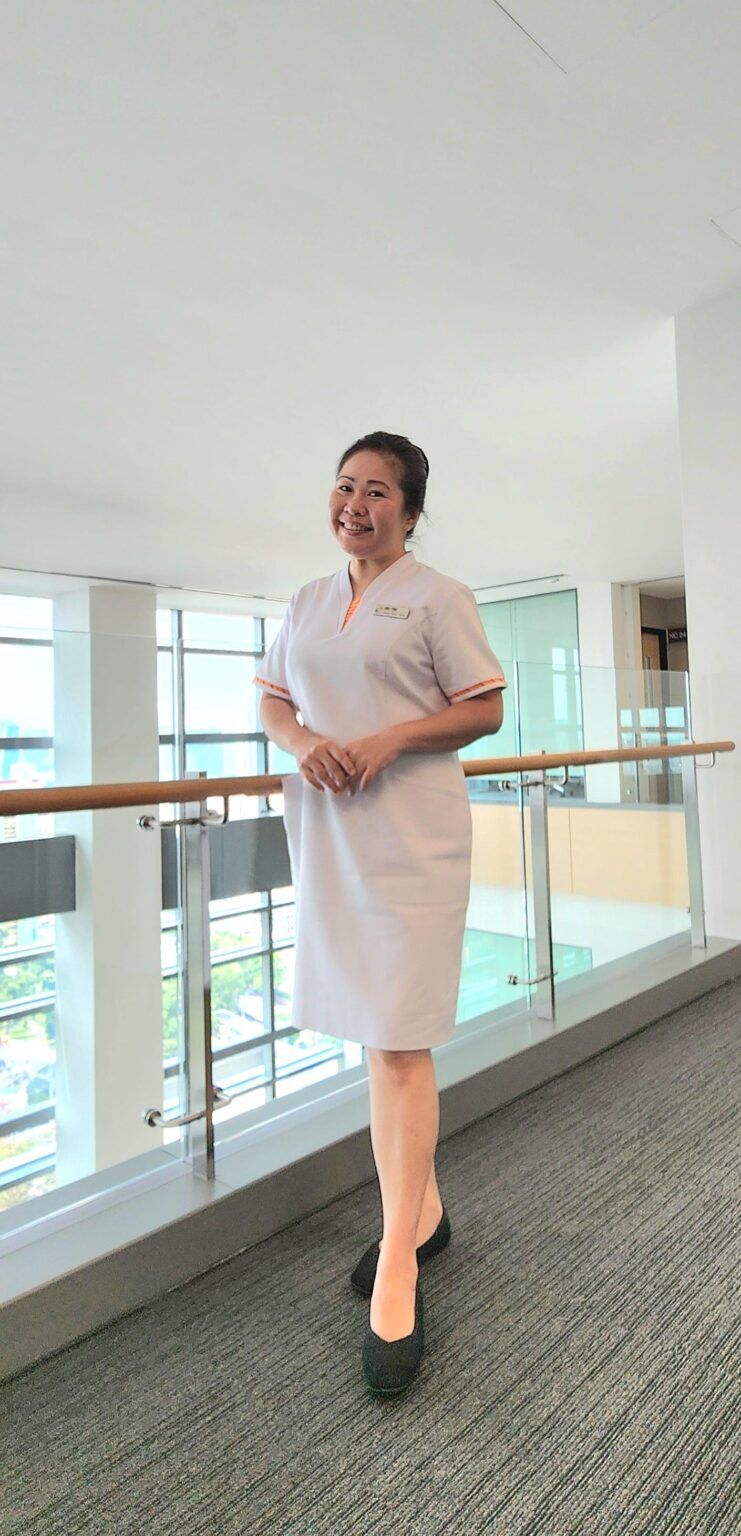How automation and robotics are reshaping care at National Cancer Centre Singapore
)
Ms Amy Ong, the Centre’s Assistant Director of Nursing, shares examples of nursing innovations and how these have boosted safety and efficiency
In 2023, the National Cancer Centre Singapore (NCCS) – the country’s primary specialty centre for oncology – shifted to a new home five times larger than its previous premises, with enhanced facilities dedicated to care, rehabilitation, research, and education.
The expanded capacity will allow the centre to meeting anticipated rising demand, as cancer prevalence increase in Singapore.
According to figures from the Singapore Cancer Registry, the country recorded 84,002 new cancer cases over the period of 2017 to 2021, as compared to 71,265 from 2013 to 2017.
This trend reflects the growing cancer burden globally. The World Health Organization pointed to population ageing and growth, tobacco and alcohol usage, as well as air pollution as some of the driving factors.
For healthcare systems around the world, this translates into a need for further investments not just into physical infrastructure and treatment capabilities, but also into staff resources.
|
|
This is compounded by the acute worldwide shortage of nurses, especially oncology nurses who are equipped with specialised skills such as delivery of chemotherapy and usage of advanced cancer treatment technologies, said Ms Amy Ong, Assistant Director of Nursing at NCCS. “We are always looking to recruit more nurses who have an interest or passion in oncology care, But we also recognise that with the rising demand, nursing shortage will likely remain a challenge. The question then is, how do we tackle this shortage while still ensuring we deliver excellent care to our patients?” |
Harnessing robotics and automation
For NCCS, the answer lies in innovation and technology. Over the past couple of years, concerted efforts and partnerships in developing innovative ideas to reduce nursing workload have borne fruit.
One of these was the Autonomous Mobile Robot for Chemotherapy Medication Delivery, or AMR for short. This robot was conceptualised to ensure timely delivery of chemotherapy drugs in the Ambulatory Treatment Unit (ATU), where outpatient chemotherapy treatment is conducted.
“The ATU now occupies one whole level of the building, with seven suites and over a hundred chairs – almost double its size in the old premises. It would be challenging for the pharmacy to deliver the right medications to each of the different suites on time,” Ms Ong noted.
With co-funding from Ministry of Health’s Smart Nursing Ward programme, the team came up with the idea for an AMR, which would automate drug delivery while not compromising on medication safety and accuracy.
The pharmacists would load up the AMR with the right medications loaded for each suite, before it is locked and set off on its pre-programmed routes to the suites. At each suite, designated staff will scan their staff pass to retrieve the medications for the suite they are responsible for.
A total of 4 AMRs now weave around the ATU daily, with each robot’s location tracked and their medication loads monitored via a screen in the pharmacy. NCCS estimates that each AMR fleet has enhanced nursing productivity by 68% with 3.93 nursing FTE (full-time equivalent) and 0.68 non-nursing FTE saved annually.
“These robots have freed up our healthcare attendants from the task of retrieving the drugs manually, and also the pharmacists from having to deliver drugs to each patient’s chair. For nurses, it has also enabled us to focus more on direct patient care and prompt medication administration,” said Ms Ong.
Autonomous commode and waste disposal for better safety and efficiency
Innovation often emerges from identifying unmet needs or unresolved challenges.
The team at NCCS observed that the process of managing patients’ biowaste was posing several challenges for nurses.
For one, patients suffering from symptoms such as dizziness or weakness face a fall risk when making their way to the toilet.
The biowaste of patients undergoing chemotherapy may contain cytotoxic by-products, which poses a risk of exposure to the patients as well as nurses.
In addition, the process of helping patients to the toilet, monitoring their intake and output, and travelling from treatment units to waste disposal rooms is time-consuming for nurses.
To tackle this, it embarked on a collaboration with Changi General Hospital, the Centre for Healthcare Assistive & Robotics Technology (CHART), Singapore University of Technology and Design (SUTD) and a vendor on the concept of an autonomous commode.
This smart commode is envisioned to be able to autonomously move to the patient’s chair once the patient presses the call bell for toileting assistance. It would then transport the waste to the disposal room, where a robotic arm would weigh and classify the type of stool – information which will be captured in the patient’s electronic record – then dispose of the waste into the macerator, and finally thoroughly disinfect the commode. This process will eliminate the need for human handling, reducing the risk posed to staff and patients, while cutting manual tasks required from staff, Ms Ong explained.
The project is currently at the proof of concept stage, with ongoing work on a prototype, she added. Fine tuning of the function of the autonomous commode will need to be done before they are officially deployed, including interoperability with other robots, as well as seamless integration into the existing process and patient flows.
Sustaining innovation and creativity across the organisation

Besides the above, NCCS’ nursing department has several other innovation projects in the pipeline. For example, one idea being developed now involves a device that helps patients with administering injections at home, to reduce the number of trips they have to make to the centre. Another is that of a bioimpedance sensor which could pick up on signs of extraversion – the leakage of chemotherapy drugs into tissue – so nurses can intervene in time.
To encourage a steady pipeline of such innovations, it is key for the organisation to provide frequent platforms for its pool of staff to brainstorm and present their ideas, said Ms Ong.
“We have various platforms to engage our staff on ideas to reduce redundant tasks in nursing and improve patient safety and care quality. In the organization, we do facilitate platforms for nurses to present their ideas. One such good example is the Shark Tank session where we gave nurses to opportunity to present their ideas on stage, with good ones selected for further development.”
Equally important is identifying challenges and barriers to innovation and looking for ways to overcome these.
Ms Ong pointed to resource constraints as the top challenge, including manpower and financial resources.
The development process of any new technology or device can be time- and effort-intensive, she noted. Budding innovators will need to do their groundwork, be ready with figures and numbers to back up their pitch, to achieve stakeholder buy-in.
The good news is that there are now more avenues of funding and support available for healthcare innovators in Singapore.
As part of the SingHealth cluster, NCCS can turn to SingHealth’s innovation office for mentorship on navigating the process or linking up with the right partners. There is also the new nursing innovation grant launched by the Academic Medicine Innovation Institute (a joint entity between SingHealth and Duke-NUS) aimed to supporting innovation development and adoption.
As the Centre continues to implement and adopt new technologies and ways of work, there may be some resistance or hesitancy, Ms Ong acknowledged.
But she notes innovation is not something that “happens overnight” – making and sustaining the change they wish to see will require efforts in building and growing support from the ground.
Ultimately, these efforts would be worthwhile if they ensure ever-better care delivered to patients, in line with the centre’s philosophy of having patients at the heart of all they do.


 Ms Amy Ong
Ms Amy Ong